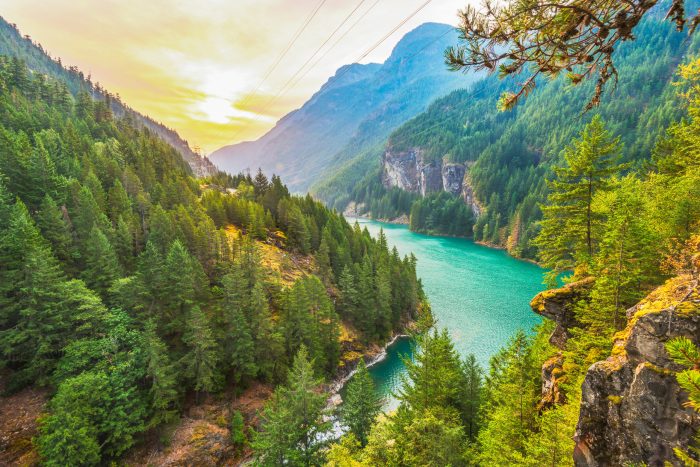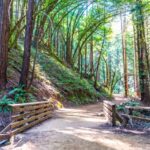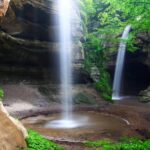Cascade Hiking Trails offer an unparalleled adventure, beckoning hikers of all skill levels to explore breathtaking landscapes. From challenging climbs with panoramic vistas to gentle strolls through lush forests, the Cascade Range presents a diverse array of trails catering to every preference. This guide delves into the heart of these iconic trails, providing insights into planning, safety, and the unique natural beauty that awaits.
We’ll cover everything from choosing the right trail based on your experience and fitness level to essential gear, safety precautions, and responsible hiking practices. Discover popular trails, learn about the region’s unique flora and fauna, and understand how to minimize your environmental impact. Prepare to be inspired to lace up your boots and embark on an unforgettable journey through the Cascade Mountains.
Popular Cascade Hiking Trails
The Cascade Mountains offer a breathtaking array of hiking trails, catering to various skill levels and preferences. From challenging climbs with rewarding summit views to gentle strolls through lush forests, the options are vast and diverse. Choosing the right trail depends on your experience, fitness level, and desired adventure. This section will highlight some of the most popular and memorable trails within the Cascade Range.
Five Popular Cascade Hiking Trails
Choosing the right trail is crucial for a safe and enjoyable experience. The following table provides a quick overview of five popular trails, categorized by location, difficulty, and estimated hiking time. Remember to always check current trail conditions and weather forecasts before embarking on your hike.
| Trail Name | Location | Difficulty | Estimated Hiking Time |
|---|---|---|---|
| Mount Rainier Skyline Trail | Mount Rainier National Park, Washington | Moderate to Strenuous | 5-8 hours |
| Tamanawas Falls Trail | Mount Hood National Forest, Oregon | Easy to Moderate | 2-4 hours |
| Dog Mountain Trail | Columbia River Gorge, Washington | Strenuous | 6-8 hours |
| Tolmie Peak Trail | Mount Rainier National Park, Washington | Moderate | 4-6 hours |
| Eagle Creek Trail | Columbia River Gorge, Oregon | Moderate to Strenuous | 6-8 hours (longer if including waterfalls) |
Detailed Descriptions of Noteworthy Trails
This section provides detailed descriptions of three noteworthy Cascade hiking trails, highlighting their unique features and landmarks. Understanding these nuances will help you better plan your adventure.
Mount Rainier Skyline Trail: This iconic trail offers unparalleled panoramic views of Mount Rainier and its surrounding landscape. The trail itself is a relatively high-altitude traverse, leading hikers through diverse terrain including subalpine meadows, forests, and rocky outcrops. Hikers often report seeing wildflowers in bloom during the summer months and breathtaking sunrises and sunsets. The trail’s length and elevation gain require a good level of fitness.
Tamanawas Falls Trail: A more accessible option, the Tamanawas Falls Trail is perfect for families and less experienced hikers. The trail winds through a lush forest, culminating in a stunning view of Tamanawas Falls. The relatively short distance and gentle incline make it a great choice for a shorter day hike. The falls themselves are a picturesque location for photography and a refreshing break point.
Dog Mountain Trail: Known for its strenuous climb and breathtaking views, Dog Mountain Trail is a popular destination for experienced hikers. The trail is characterized by a steep, relentless ascent through wildflowers (during peak season) to the summit, offering panoramic vistas of the Columbia River Gorge. The trail’s popularity necessitates an early start to avoid crowds and secure parking.
Comparative Analysis of Three Trails
This table compares three trails across key metrics to aid in trail selection based on your preferences and capabilities. Factors like elevation gain and trail length directly impact the difficulty and required time commitment. Hiker reviews provide valuable insights into the overall experience.
| Trail Name | Elevation Gain (feet) | Trail Length (miles) | Average Hiker Review (out of 5 stars – estimated) |
|---|---|---|---|
| Mount Rainier Skyline Trail | ~3000 | 5.5 | 4.5 |
| Tamanawas Falls Trail | ~800 | 2.8 | 4.2 |
| Dog Mountain Trail | ~2800 | 6.7 | 4.0 |
Planning a Cascade Hiking Trip

Planning a Cascade hiking trip requires meticulous preparation to ensure a safe and enjoyable experience. The Cascade Range presents diverse terrain, weather conditions, and potential hazards, demanding a proactive approach to trip planning. Overlooking even minor details can significantly impact your safety and enjoyment. This guide provides a structured approach to planning your adventure.
Trip Planning Steps
A well-structured plan is the cornerstone of a successful Cascade hiking trip. Failing to plan adequately increases the risk of encountering unforeseen challenges, leading to discomfort or even danger. This step-by-step process will help you navigate the planning phase effectively.
- Choose Your Trail: Select a trail appropriate for your fitness level and experience. Consider the trail’s length, elevation gain, difficulty rating, and the time of year. Research trail conditions and recent trip reports from other hikers to gauge current accessibility and potential hazards.
- Check Weather Forecasts: Cascade weather can be unpredictable. Monitor forecasts closely leading up to and during your trip. Be prepared for sudden changes in conditions, including rain, snow, and extreme temperatures. Pack layers of clothing to adapt to fluctuating weather.
- Obtain Necessary Permits and Reservations: Some Cascade trails require permits or reservations, particularly during peak season. Check with the relevant land management agency (e.g., the National Park Service, US Forest Service) well in advance to secure the necessary permits and avoid disappointment.
- Develop an Itinerary: Create a detailed itinerary including your planned hiking schedule, rest stops, and emergency contact information. Share this itinerary with a trusted friend or family member who is not on the trip. This itinerary should include planned arrival and departure times, as well as potential alternative routes.
- Pack Appropriately: Proper packing is crucial for safety and comfort. Pack for all possible weather conditions, considering both warm and cold layers. Ensure you have sufficient water, food, and first-aid supplies. (Further details on essential gear are provided below).
Essential Gear and Equipment
The right gear can make or break your Cascade hiking experience. Investing in quality equipment that is appropriate for the conditions you will encounter is a critical element of trip planning. This section categorizes essential items to aid in your preparation.
Clothing
Proper clothing is essential for maintaining comfort and safety in the varied Cascade weather. Consider layering your clothing to adapt to changing conditions.
- Moisture-wicking base layers: These help to keep sweat away from your skin, preventing chills.
- Insulating mid-layers: Fleece or down jackets provide warmth in colder conditions.
- Waterproof and windproof outer shell: Protects you from rain, snow, and wind.
- Hiking boots: Sturdy, waterproof boots with good ankle support are essential for traversing uneven terrain.
- Hiking socks: Choose moisture-wicking socks to prevent blisters.
Safety Equipment
Safety should be a paramount concern. These items are crucial for mitigating potential risks.
- First-aid kit: A comprehensive kit containing bandages, antiseptic wipes, pain relievers, and any personal medications.
- Headlamp or flashlight: Essential for navigating in low-light conditions.
- Sunscreen and sunglasses: Protect your skin and eyes from the sun’s harmful rays, even on cloudy days.
- Insect repellent: Depending on the season and location, insect repellent can be necessary to prevent bites.
- Emergency whistle: To signal for help in case of an emergency.
- Bear spray (where applicable): In areas with bears, carrying bear spray is a crucial safety measure. Learn how to use it properly before your trip.
Navigation Items
Accurate navigation is critical, especially in areas with limited cell service.
- Map and compass: Essential for navigation, even with GPS devices. Learn how to use them effectively before your trip.
- GPS device or smartphone with GPS capabilities: A backup navigation system, but remember that batteries can die.
Leave No Trace Principles
The Leave No Trace principles are crucial for preserving the pristine beauty of the Cascade Mountains for future generations. Following these guidelines ensures minimal environmental impact.
“Leave No Trace: Plan ahead and prepare; Travel and camp on durable surfaces; Dispose of waste properly; Leave what you find; Minimize campfire impacts; Respect wildlife; Be considerate of other visitors.”
Practicing Leave No Trace involves packing out all trash, minimizing campfire impacts (consider using a lightweight stove instead), staying on established trails, and respecting wildlife by observing them from a distance. Proper waste disposal is critical; pack out everything you pack in. By following these principles, you contribute to the preservation of these magnificent trails for years to come.
Environmental Aspects of Cascade Hiking Trails

The Cascade Mountains, a breathtaking expanse of volcanic peaks and lush forests, offer unparalleled hiking experiences. However, responsible enjoyment of these trails necessitates a deep understanding of their delicate ecosystems and the potential impact of human activity. This section delves into the environmental considerations crucial for preserving the natural beauty and biodiversity of the Cascade Range for generations to come.
Cascade Flora and Fauna, Cascade Hiking Trails
The Cascade ecosystem boasts remarkable biodiversity. From the subalpine meadows to the dense old-growth forests, a vast array of plant and animal life thrives. High-elevation areas often feature wildflowers like lupine and paintbrush, while lower elevations support coniferous forests dominated by Douglas fir, western hemlock, and ponderosa pine. Wildlife sightings are common, including black bears, deer, elk, various bird species (like the Steller’s jay and the American robin), and smaller mammals such as marmots and squirrels.
The specific flora and fauna encountered will vary significantly depending on the altitude and trail location. For example, the Mount Rainier National Park trails will showcase different species compared to those in the North Cascades National Park. Understanding this biodiversity is essential for respecting the delicate balance of the ecosystem.
Ecological Impact of Hiker Traffic and Mitigation Strategies
Increased hiker traffic can significantly impact the Cascade ecosystem. Trail erosion, damage to vegetation, and disturbance of wildlife are major concerns. Compacted soil reduces water infiltration, leading to increased runoff and erosion. Off-trail hiking can damage sensitive vegetation and create new, unsustainable trails. Human waste improperly disposed of poses a significant health and environmental risk.Mitigation strategies focus on minimizing these impacts.
These include promoting responsible trail use through education campaigns emphasizing “Leave No Trace” principles, which involve packing out all trash, staying on marked trails, and minimizing campfire impacts. Regular trail maintenance, including erosion control measures and vegetation restoration, is also crucial. Implementing trail rationing or permit systems during peak seasons can help manage visitor numbers and prevent overcrowding.
Investing in improved trail infrastructure, such as boardwalks and bridges, can minimize soil compaction and protect sensitive areas. Finally, educating hikers about the importance of wildlife observation from a safe distance is crucial to minimize disturbance to animal behavior and habitats.
Potential Environmental Hazards and Safety Precautions
Several environmental hazards exist along Cascade hiking trails. These include steep and unstable terrain leading to falls, exposure to extreme weather conditions (such as sudden storms, snow, and ice), and encounters with wildlife (primarily bears). Additionally, poisonous plants, such as poison oak, can pose a risk to hikers. Water sources might be contaminated, necessitating water purification or treatment.Safety precautions are paramount.
Hikers should always be well-prepared, including carrying appropriate clothing and gear for varied weather conditions, bringing sufficient food and water, and using a map and compass or GPS device. Proper bear safety practices, such as storing food properly and making noise while hiking, are essential. First-aid training and carrying a well-stocked first-aid kit are crucial. Hikers should also check weather forecasts before embarking on a hike and inform someone of their hiking plans.
Knowing how to identify and avoid poisonous plants is also important, and understanding water purification techniques is critical to avoiding waterborne illnesses.
Exploring the Cascade Hiking Trails is more than just a hike; it’s an immersion into a vibrant ecosystem and a testament to the power of nature. By understanding the nuances of trail selection, preparation, and responsible outdoor ethics, you can ensure a safe, rewarding, and memorable experience. Remember to always prioritize safety, respect the environment, and leave no trace—allowing future generations to enjoy these incredible trails for years to come.
So, pack your bags, grab your hiking poles, and get ready for an adventure that will leave you breathless.

